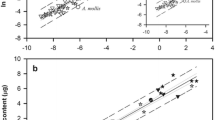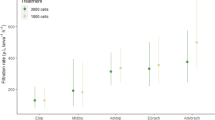Abstract
Lecithotrophic larvae of the cheilostome bryozoan, Bugula neritina (L.), lose metamorphic competence 12 to 24 h after release from the maternal zooid. The high respiration rate of newly released larvae (mean=306.3 pmol O2 larva-1 h-1, range=149.3 to 466.6, n=18 trials, 22.5°C) from adults collected at Link Port, Fort Pierce, Florida during the winter/spring of 1990–1991 reflects their active swimming behavior. The average energy content per larva was 15.24 mJ (range: 13.35 to 20.17 mJ ind-1, n=5 groups). If all cells have an identical energy content and metabolic rate, then 2 and 20% of the total energy content would be consumed by the onset (2 h post-release) and the loss (24 h post-release) of metamorphic competence. Larvae of B. neritina are a composite of both larval and juvenile tissues and the loss of metamorphic competence may be due to regional depletion of labile energy stores in transitory “larval” cells, particularly the ciliated cells that comprise the locomotory organ, the corona. Although “nonfeeding”, B. neritina larvae can acquire nutrients from the environment in the form of dissolved organic materials (DOM) in seawater. Both the amino acid alanine and the fatty acid palmitic acid can be transported from seawater ([S]=1 μM, 22.5°C). The rates of alanine influx (appearance of label in tissue) averaged 0.366 pmol larva-1 h-1 and, based on comparisons between rates of solute transport and metabolism, would contribute little (<1% of required energy) to offset the metabolic demand. The average rate of palmitic acid influx was 4.668 pmol larva-1 h-1 and assuming that the measured influx equals the net solute flux, could account for 21 to 72% of energy requirements. These data suggest that the duration of planktonic life of B. neritina larvae is principally regulated by the amount of endogenous energy stores, but may be modulated by available DOM in seawater.
Similar content being viewed by others
References
Bass N, Chapman G, Chapman JM (1969) Uptake of leucine by larvae and adults of Nereis. Nature, Lond 221:476–477
Birkeland C, Chia F-S, Strathmann RR (1971) Development, substratum selection, delay of metamorphosis and growth in the seastar, Mediaster aequalis. Biol Bull mar biol Lab, Woods Hole 141:99–108
Bunde TA, Friede M (1978) The uptake of dissolved free fatty acids from seawater by a marine filter feeder, Crassostrea virginica. Comp Biochem Physiol 60A:139–144
Carlucci AF, Craven DB, Hendricks SM (1984) Diel production and microheterotrophic utilization of dissolved free amino acids in waters off southern California. Appl envirl Micro 48:165–170
Crisp DJ (1974) Energy relations of marine invertebrate larvae. Thalassia jugosl 10:103–120
Davis JP, Stephens GC (1984) Uptake of free amino acids by bacteria-free larvae of the sand dollar Dendraster excentricus. Am J Physiol 247:R733-R739
Epel D (1972) Activation of Na+-dependent amino acid transport system upon fertilization of sea urchin eggs. Expl Cell Res 72: 74–89
Erickson JT (1984) Gradient-diver respirometry applied to free-swimming larvae of the queen conch Strombus gigas Linne. J Shellfish Res 4:5–15
Gerdes D (1983) The Pacific oyster Crassostrea gigas. Part II. Oxygen consumption of larvae and adults. Aquaculture, Amsterdam 31:221–231
Gnaiger E (1983) Calculation of energetic and biochemical equivalents of respiratory oxygen consumption. In: Gnaiger E, Forstner H (eds) Polarographic oxygen sensors. Springer-Verlag, Berlin, pp 337–345
Jaeckle WB, Manahan DT (1989a) Feeding by a “nonfeeding” larva: uptake of dissolved amino acids from seawater by lecithotrophic larvae of the gastropod Haliotis rufescens Swainson. Mar Biol 103:87–94
Jaeckle WB, Manahan DT (1989b) Amino acid uptake and metabolism by larvae of the marine worm Urechis caupo, a new species in axenic culture. Biol Bull mar biol Lab, Woods Hole 175: 317–326
Jaeckle WB, Manahan DT (1989c) Growth and energy imbalance during the development of a lecithotrophic molluscan larva (Haliotis rufescens). Biol Bull mar biol Lab, Woods Hole 177:237–246
Jeffrey LM (1970) Lipids in marine waters. In: Hood DW (ed) Symposium on organic matter in natural water. Publ. 1. University of Alaska, College, pp 55–76
Johannes RE, Coward SJ, Webb KL (1969) Are dissolved amino acids an energy source for marine invertebrates? Comp Biochem Physiol 29:283–288
Kempf SC (1981) Long-lived larvae of the gastropod Aplysia juliana: do they disperse and metamorphose or just slowly fade away? Mar Ecol Prog Ser 6:61–65
Keough MJ (1984) Kin-recognition and the spatial distribution of larvae of the bryozoan Bugula neritina. Evolution, Lawrence, Kansas 38:142–147
Keough MJ (1989) Dispersal of the bryozoan Bugula neritina and effects of adults on newly metamorphosed juveniles. Mar Ecol Prog Ser 57:163–171
Lucas MI, Walker G, Holland DL, Crisp DJ (1979) An energy budget for the free-swimming and metamorphosing larvae of Balanus balanoides (Crustacea: Cirripedia). Mar Biol 55:221–229
McEdward LR, Coulter LK (1987) Egg volume and energetic content are not correlated among sibling offspring of starfish: implications for life-history theory. Evolution, Lawrence, Kansas 41: 914–917
Manahan DT (1983) The uptake of dissolved glycine following fertilization of oyster eggs (Crassostrea gigas Thunberg). J exp mar Biol Ecol 68:53–58
Manahan DT (1989) Amino acid fluxes to and from seawater in axenic veliger larvae of a bivalve (Crassostrea gigas). Mar Ecol Prog Ser 53:247–255
Manahan DT (1990) Adaptations by invertebrate larvae for nutrient acquisition from seawater. Am Zool 30:147–160
Manahan DT, Jaeckle WB, Nourizadeh S (1989) Ontogenic changes in the rates of amino acid transport from seawater by marine invertebrate larvae (Echinodermata, Echiura, Mollusca). Biol Bull mar biol Lab, Woods Hole 76:161–168
Mann R, Gallager SM (1985) Physiological and biochemical energetics of larvae of Teredo navalis L. and Bankia gouldi (Bartsch) (Bivalvia: Teredinidae). J exp mar Biol Ecol 85:211–228
Mopper K, Lindroth P (1982) Diel and depth variations in dissolved free amino acids and ammonium in the Baltic Sea determined by shipboard HPLC analysis. Limnol Oceanogr 27:336–347
Nielsen C (1981) On morphology and reproduction of “Hippodiplosia” insculpta and Fenestrulina malusii (Bryozoa, Cheilostomata). Ophelia 20:91–125
Parsons TR, Maita Y, Lalli CM (1984) A manual of chemical and biological methods for seawater analysis. Pergamon Press, Oxford
Pechenik JA (1980) Growth and energy balance during the larval lives of three prosobranch gastropods J exp mar Biol Ecol 44: 1–28
Pechenik JA (1986) Field evidence for delayed metamorphosis of larval gastropods: Crepidula plana (Say) Crepidula fornicata (L.), and Bittium alternatum (Say). J exp mar Biol Ecol 97: 313–319
Pechenik JA (1990) Delayed metamorphosis by larvae of henthic marine invertebrates: does it occur? Is there a price to pay? Ophelia 32:63–94
Reed CG (1991) Bryozoa. In: Giese AC, Pearse JS, Pearse VB (eds) Reproduction of marine invertebrates: echinoderms and lophophorates, Vol. 6. The Boxwood Press, California, pp 85–245
Reish DJ, Stephens GC (1969) Uptake of organic material by aquatic invertebrates. V. The influence of age on the uptake of glycine-14C by the polychaete Neanthes arenaceodentata. Mar Biol 3: 352–355
Scheltema RS (1974) Biological interactions determining larval settlement of marine invertebrates. Thalassia jugosl 10:263–296
Shilling FM, Manahan DT (1990) Energetics of early development for the sea urchins Strongylocentrotus purpuratus and Lytechinus pictus and the crustacean Artemia sp. Mar Biol 106:119–128
Sprung M (1984a) Physiological energetics of mussel larvae (Mytilus edulis). I. Shell growth and biomass. Mar Ecol Prog Ser 17: 283–293
Sprung M (1984b) Physiological energetics of mussel larvae (Mytilus edulis). II. Respiration. Mar Ecol Prog Ser 18:171–178
Testerman JK (1972) Accumulation of free fatty acids from seawater by marine invertebrates. Biol Bull mar biol Lab, Woods Hole 142:160–177
Thorson G (1950) Reproductive and larval ecology of marine bottom invertebrates. Biol Rev 25:1–45
Turner RL, Lawrence JM (1979) Volume and composition of echinoderm eggs: implications for the use of egg size in life-history models. In: Stancyk SE (ed) Reproductive ecology of marine invertebrates. U. So. Carolina Press, Columbia, pp 25–40
Ussing HH (1949) Transport of ions across cellular membranes. Physiol Rev 29:127–155
Woollacott RM, Pechenik JA, Imbalzano KM (1989) Effects of duration of larval swimming period on early colony development in Bugula stolonifera (Bryozoa: Cheilostomata). Mar Biol 102: 57–63
Woollacott RM, Zimmer RL (1971) Attachment and metamorphosis of the cheilo-ctenostome bryozoan Bugula neritina (Linne). J Morph 134:351–382
Welborn JR, Manahan DT (1990) Direct measurements of sugar uptake from seawater into molluscan larvae. Mar Ecol Prog Ser 65: 233–239
Young CM, Chia F-S (1981) Laboratory evidence for delay of larval settlement in response to a dominant competitor. Int J Invert Reprod Dev 3:221–226
Zimmer RL, Woollacott RM (1977a) Structure and classification of gymnolaemate larvae. In: Woollacott RM, Zimmer RL (eds) Biology of bryozoans. Academic Press, San Francisco, pp 57–89
Zimmer RL, Woollacott RM (1977b) Metamorphosis, ancestrulae, and coloniality in bryozoan life cycles. In: Woollacott RM, Zimmer RL (eds) Biology of bryozoans. Academic Press, San Francisco, pp 91–142
Author information
Authors and Affiliations
Additional information
Communicated by J.P. Grassle, New Brunswick
Rights and permissions
About this article
Cite this article
Jaeckle, W.B. Rates of energy consumption and acquisition by lecithotrophic larvae of Bugula neritina (Bryozoa: Cheilostomata). Marine Biology 119, 517–523 (1994). https://doi.org/10.1007/BF00354313
Received:
Accepted:
Issue Date:
DOI: https://doi.org/10.1007/BF00354313




